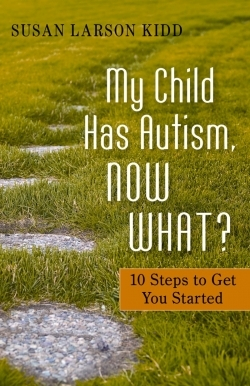My Child has Autism, Now What?
10 Steps to Get You Started
A diagnosis of autism can rock a parent’s foundation. And what do parents do once they get home from the doctor’s office? Often they turn to the internet for answers. But, as educational and behavioral consultant Susan Larson Kidd points out, there’s a lot of information out there that’s either wrong or unnecessary. Parents in the first stages of confusion and uncertainty may feel even more overwhelmed by the staggering number of hits they get with a search engine.
Kidd’s book, My Child Has Autism, Now What? is a terrific first step on the pathway to education and adaptation. A diagnosis of autism spectrum disorder is not the end of the world, but the beginning; Kidd’s clear, matter-of-fact explanations of terms and ideas on how to teach and communicate with autistic children can make those first few weeks and months a positive learning experience instead of time wasted on confusion and guilt.
To start with, Kidd, who specializes in autism spectrum disorder and attention deficit hyperactivity disorder, addresses some of the basic training issues that may have been causing extreme frustration in the family. Kidd shows parents how to illustrate the sequence of events surrounding everyday tasks–eating, using the toilet, going to bed–with pictures and photographs. Routines that children with autism may have trouble adapting to become clearer and easier to follow with visual reminders. She also informs parents that the senses of autistic children often work overtime, and smells, sights, and sounds that may feel normal to us may be traumatic to our children and need to be altered or removed.
Kidd describes the different kinds of therapy available, the role of the school system, how music and organization can help autistic children, and many other issues facing parents of the newly diagnosed.
Kidd writes in a welcoming, conversational manner and includes further resources at the end of each chapter. Her book is less like a manual and more like a conversation; above all her advice is friendly and easy to follow. By focusing on the practical aspects of dealing with a diagnosis of autism instead of delving into extensive theory, she keeps her book appropriate for family members and educators who are new to this arena and need concrete information to improve daily life. Her book is perfect for families on the cusp of a new world.
Reviewed by
Andi Diehn
Disclosure: This article is not an endorsement, but a review. The publisher of this book provided free copies of the book and paid a small fee to have their book reviewed by a professional reviewer. Foreword Reviews and Clarion Reviews make no guarantee that the publisher will receive a positive review. Foreword Magazine, Inc. is disclosing this in accordance with the Federal Trade Commission’s 16 CFR, Part 255.

